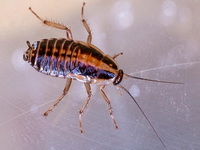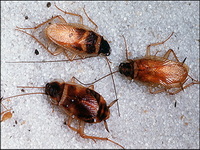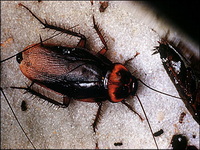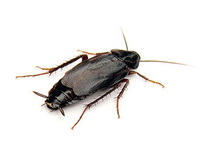



Cockroaches
Humans seem to instinctively recoil from the sight of a cockroach, and for good reason. Roaches carry pathogens (a bacterium, virus, or other microorganism that can cause disease) that can cause cholera, dysentery, diarrhea and typhoid fever. Many people are allergic to roaches, and this can cause severe asthma that are particularly dangerous in children. It is especially important to contact us immediately when you see a roach as the roach population in your home grows exponentially and you can very quickly find that you have a serious problem on your hands. A female roach can produce 4 to 20 ootheca (egg cases) during her lifetime, and each ootheca can contain 18 to 30 eggs. There are many different species of cockroach, but most species that you will see in a home are brown, roughly oval in shape with an oily sheen and a ‘slick’ feel.
Four types of cockroach are often found in Missouri homes. The German cockroach is a frequent kitchen invader and the Brown-banded cockroach can be found anywhere in the home where a hiding space is available. American cockroaches tend to be found mostly in industrial settings such as restaurants and grocery stores, but can thrive anywhere there is a large amount of garbage available as a food source. Oriental cockroaches will most often be found in basements or near leaky plumbing.
German Cockroach
German cockroaches are light brown to tan with two dark stripes located on their backs. They are oval shaped with six legs and antennae and can be found across the United States. They are the most common cockroach found worldwide. The German cockroach prefers dark, damp places, which is why they’re often found in the kitchen. They prefer to hide under or around sinks, appliances, cupboards and baseboards. They usually cluster together in large numbers inside cracks and crevices near warm areas with high humidity. These populations build up in terrific numbers and will likely be resistant to any store-bought pesticide. They can eat almost anything, including glue, soap and toothpaste. Germans spread disease by picking up germs on the spines of their legs and transferring those germs to food and surface areas that a human might touch. Their bodies contain proteins that are a well known trigger for asthma, especially in young children. Although they have wings, this species rarely flies and prefers to run instead.
Brown-banded Cockroach
Brown-banded cockroaches are brown with very noticeable lighter brown banding across their wings and can be found throughout the United States. They tend to prefer warmer and drier nesting sites than any of the other urban pest roaches. They may often be found behind picture frames, clocks or other objects on walls or in closets, underneath tables, chairs, cupboards and cabinets. They may also be found inside electronic equipment and in lamps or furniture in dining rooms, bedrooms and living rooms. You will often find their egg cases in or underneath furniture, for instance underneath your couch cushions.
American Cockroach
American cockroaches are reddish brown with a yellowish figure 8 pattern on the back of their head. They are the largest of the house-infesting roaches and can be found worldwide. American cockroaches prefer very damp, very dark places are often found in sewers and basements, particularly around leaking pipes and drains. They will also congregate in kitchens, bathrooms and laundry rooms in search of water and food. They are most active when the temperature is relatively high.
Oriental Cockroach
Oriental Cockroaches are large and exhibit a shiny black to dark reddish-brown color and are usually found in the northern regions of the United States. Oriental cockroaches frequently infest sewer systems and will enter structures through drains or through door thresholds, typically during the summer. Once inside, this species will seek out damp and cool places such as basements and crawl spaces. They are often referred to as ‘water bugs’ in the US. This species creates a strong smell and is considered one of the dirtiest of all the cockroaches.
Roach infestations aren’t caused solely by poor hygiene, but maintaining a high level of cleanliness in the home can reduce your chances of ever becoming infested and make it much easier to exterminate an infestation once it occurs. See the video below for some good advice on how to maintain a cockroach free home.
Houseman, Richard. “Cockroaches.” University of Missouri Extension, 1 Jan. 2002, extension.missouri.edu/publications/g7384.
“German Cockroaches.” Pest World, www.pestworld.org/pest-guide/cockroaches/german-cockroaches/.